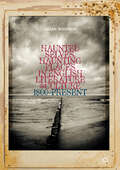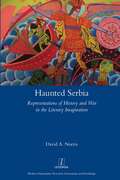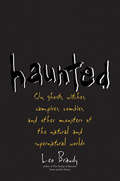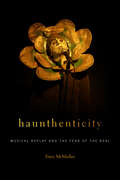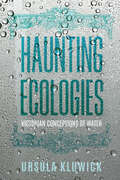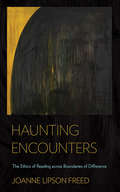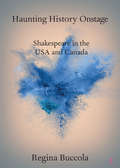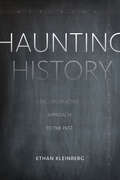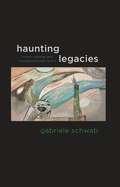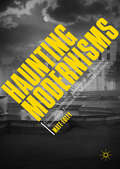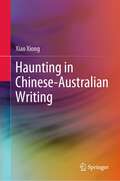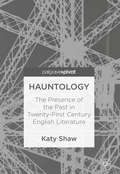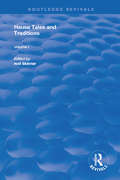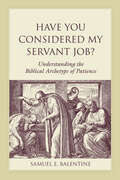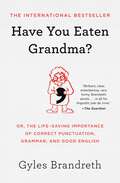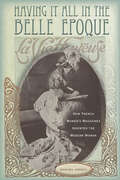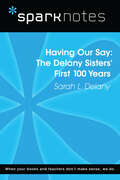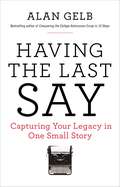- Table View
- List View
Haunted Selves, Haunting Places in English Literature and Culture: 1800–Present
by Julian WolfreysHaunted Selves, Haunting Places in English Literature and Culture offers a series of readings of poetry, the novel and other forms of art and cultural expression, to explore the relationship between subject and landscape, self and place. Utilizing an interdisciplinary approach grounded in close reading, the text places Jacques Derrida’s work on spectrality in dialogue with particular aspects of phenomenology. The volume explores writing and culture from the 1880s to the present day, proceeding through four sections examining related questions of identity, memory, the landscape, and our modern relationship to the past. Julian Wolfreys presents a theoretically informed understanding of the efficacy of literature and culture in connecting us to the past in an affective and engaged manner.
Haunted Serbia: Representations of History and War in the Literary Imagination (Legenda)
by David NorrisHaunting is what happens when the past is disturbed and the victims of previous violence, who are thought to be buried and forgotten, are brought back to the present and made to live again. Serbian fiction writers of the 1980s exhume the ghosts of the past, re-remembering the cruelty of the twentieth century, reinterpreting the heroic role of the Partisans and the extraordinary measures taken to defend Yugoslavia’s recently won independence and socialist revolution. Their uncanny and ghostly imagery challenges the assumptions of the master discourse promoted by the country’s orthodox communist authorities and questions the historical roots of social and cultural identities. The instability of this period of transition is deepened during the wars of the 1990s, when authors turn from the memory of past violence to face the ferocious brutality of new conflicts. The haunting evocations in their work continue to articulate fresh uncertainties as the trappings of modern civilization are stripped away and replaced by the destructive logic of civil war. The past returns once more with renewed energy in the struggle to make sense of a vastly changed world.
Haunted narratives
by Therese Steffen Tiina Kirss Gabriele Rippl Philipp Schweighauser Margit SutropExploring life writing from a variety of cultural contexts, Haunted Narratives provides new insights into how individuals and communities across time and space deal with traumatic experiences and haunting memories. From the perspectives of trauma theory, memory studies, gender studies, literary studies, philosophy, and post-colonial studies, the volume stresses the lingering, haunting presence of the past in the present. The contributors focus on the psychological, ethical, and representational difficulties involved in narrative negotiations of traumatic memories.Haunted Narratives focuses on life writing in the broadest sense of the term: biographies and autobiographies that deal with traumatic experiences, autobiographically inspired fictions on loss and trauma, and limit-cases that transcend clear-cut distinctions between the factual and the fictional. In discussing texts as diverse as Toni Morrison's Beloved, Vikram Seth's Two Lives, deportation narratives of Baltic women, Christa Wolf's Kindheitsmuster, Joy Kogawa's Obasan, and Ene Mihkelson's Ahasveeruse uni, the contributors add significantly to current debates on life writing, trauma, and memory; the contested notion of "cultural trauma"; and the transferability of clinical-psychological notions to the study of literature and culture.
Haunted: On Ghosts, Witches, Vampires, Zombies, and Other Monsters of the Natural and Supernatural Worlds
by Leo BraudyAn award-winning scholar and author charts four hundred years of monsters and how they reflect the culture that created them Leo Braudy, a finalist for both the National Book Award and the National Book Critics Circle Award, has won accolades for revealing the complex and constantly shifting history behind seemingly unchanging ideas of fame, war, and masculinity. Continuing his interest in the history of emotion, this book explores how fear has been shaped into images of monsters and monstrosity. From the Protestant Reformation to contemporary horror films and fiction, he explores four major types: the monster from nature (King Kong), the created monster (Frankenstein), the monster from within (Mr. Hyde), and the monster from the past (Dracula). Drawing upon deep historical and literary research, Braudy discusses the lasting presence of fearful imaginings in an age of scientific progress, viewing the detective genre as a rational riposte to the irrational world of the monstrous. Haunted is a compelling and incisive work by a writer at the height of his powers.
Haunthenticity: Musical Replay and the Fear of the Real (Music / Culture Ser.)
by Tracy McMullenAn interdisciplinary and existential exploration of live musical reenactment In this persuasive study, Tracy McMullen draws on philosophy, psychology, musicology, performance studies, and popular music studies in order to analyze the rise of obsessively precise live musical reenactments in the United States at the turn of the millennium. She investigates this practice, what she terms, Replay, in popular music, jazz, and performance art arguing that it is a symptom of deep-seated fears of the fleeting nature of identity. Musical Replay claims a type of authenticity that is grounded in the exact material details of the original (instruments, props, costumes, people, etc.), and attempts to make up for the loss of identity: cloning the past and using it as a replacement. The scholarship is wide-ranging and ties theory and evidence from diverse fields and experiences together seamlessly and convincingly. Haunthenticity: Musical Replay and the Fear of the Real ultimately argues for a new way of conceiving subjectivity and identity within critical and cultural studies, moving beyond Western epistemologies.
Haunting Ecologies: Victorian Conceptions of Water (Victorian Literature and Culture Series)
by Ursula KluwickVictorians&’ views of water and its role in how the social fabric of Victorian Britain was imagined Water matters like few other substances in people&’s daily lives. In the nineteenth century, it left its traces on politics, urban reform, and societal divisions, as well as on conceptualizations of gender roles. Drawing on the methodology of material ecocriticism, Ursula Kluwick&’s Haunting Ecologies argues that Victorian Britons were keenly aware of aquatic agency, recognizing water as an active force with the ability to infiltrate bodies and spaces. Kluwick reads works by canonical writers such as Braddon, Dickens, Stoker, and George Eliot alongside sanitary reform discourse, court cases, journalistic articles, satirical cartoons, technical drawings, paintings, and maps. This wide-ranging study sheds new light on Victorian-era anxieties about water contamination as well as on how certain wet landscapes such as sewers, rivers, and marshes became associated with moral corruption and crime. Applying ideas from the field of blue humanities to nineteenth-century texts, Haunting Ecologies argues for the relevance of realism as an Anthropocene form.
Haunting Encounters: The Ethics of Reading across Boundaries of Difference
by Joanne Lipson FreedActs of cross-cultural reading have ethical consequences. In Haunting Encounters, Joanne Lipson Freed traces the narrative strategies through which certain works of fiction forge connections with their readers across boundaries of difference. Freed uses the idea of haunting—an intense, temporary, and transformative encounter that defies rational understanding—as a metaphor for the kinds of ethical relationships that such works cultivate with their readers across boundaries of difference. Freed points out how such works as Toni Morrison's Beloved, Leslie Marmon Silko's Ceremony, and Arundhati Roy's The God of Small Things strike a delicate balance between empathy and alterity. Their engaging narratives, Freed argues, bring unfamiliar characters and distant settings to life for readers who encounter them as "other," but they also highlight the limits of fiction, holding in check the impulse to colonize another's experience with one's own. Haunting Encounters is a sensitive and perceptive application of theory to real-world concerns. It draws together the fields of postcolonial fiction and narrative ethics and suggests original modes of engagement between readers and books that promise new ways of looking at the world.
Haunting History Onstage: Shakespeare in the USA and Canada (Elements in Shakespeare Performance)
by Regina BuccolaIn 2016, Chicago Shakespeare Theater and the Stratford Festival of Canada mounted marathons through Shakespearean history to commemorate the 400th anniversary of the death of Shakespeare with Tug of War and Breath of Kings. Both productions invited parallels to contemporary political events in their promotion and design, just as the original performances of these works in the Shakespearean era used past events to comment on present realities. Endurathons for cast and audience alike, Tug of War and Breath of Kings used double-casting, stylized treatments of violence and 'firsts' for each company to sweeten the bitter pill of these historical narratives.
Haunting History: For a Deconstructive Approach to the Past
by Ethan KleinbergThis book argues for a deconstructive approach to the practice and writing of history at a moment when available forms for writing and publishing history are undergoing radical transformation. To do so, it explores the legacy and impact of deconstruction on American historical work; the current fetishization of lived experience, materialism, and the "real;" new trends in philosophy of history; and the persistence of ontological realism as the dominant mode of thought for conventional historians. Arguing that this ontological realist mode of thinking is reinforced by current analog publishing practices, Ethan Kleinberg advocates for a hauntological approach to history that follows the work of Jacques Derrida and embraces a past that is at once present and absent, available and restricted, rather than a fixed and static snapshot of a moment in time. This polysemic understanding of the past as multiple and conflicting, he maintains, is what makes the deconstructive approach to the past particularly well suited to new digital forms of historical writing and presentation.
Haunting Legacies: Violent Histories and Transgenerational Trauma
by Gabriele SchwabFrom mass murder to genocide, slavery to colonial suppression, acts of atrocity have lives that extend far beyond the horrific moment. They engender trauma that echoes through later generations, for those on both sides of the act. Gabriele Schwab reads these legacies in a number of narratives, primarily through the writing of postwar Germans and the descendents of Holocaust survivors. She connects their work to earlier histories of slavery and colonialism and to more recent events, such as South African Apartheid, the practice of torture after 9/11, and the "disappearances" that occurred during South American dictatorships. Schwab's texts include memoirs (Ruth Kluger's Still Alive and Marguerite Duras's La Douleur), second-generation accounts by the children of Holocaust survivors (Georges Perec's W, Art Spiegelman's Maus, and Philippe Grimbert's Secret), and second-generation recollections by Germans (W. G. Sebald's Austerlitz, Sabine Reichel's What Did You Do in The War, Daddy?, and Ursula Duba's Tales from a Child of the Enemy). She also incorporates her own reminiscences of growing up in postwar Germany, mapping networks of interlaced memories and histories as they interact in psychic life and cultural memory. Her critical approach draws on theories from psychoanalysis, postcolonialism, and trauma studies, and Schwab concludes with a bracing look at issues of responsibility, reparation, and forgiveness across the victim/perpetrator divide.
Haunting Legacies: Violent Histories and Transgenerational Trauma
by Gabriele SchwabFrom mass murder to genocide, slavery to colonial suppression, acts of atrocity have lives that extend far beyond the horrific moment. They engender trauma that echoes for generations, in the experiences of those on both sides of the act. Gabriele Schwab reads these legacies in a number of narratives, primarily through the writing of postwar Germans and the descendents of Holocaust survivors. She connects their work to earlier histories of slavery and colonialism and to more recent events, such as South African Apartheid, the practice of torture after 9/11, and the "disappearances" that occurred during South American dictatorships.Schwab's texts include memoirs, such as Ruth Kluger's Still Alive and Marguerite Duras's La Douleur; second-generation accounts by the children of Holocaust survivors, such as Georges Perec's W, Art Spiegelman's Maus, and Philippe Grimbert's Secret; and second-generation recollections by Germans, such as W. G. Sebald's Austerlitz, Sabine Reichel's What Did You Do in the War, Daddy?, and Ursula Duba's Tales from a Child of the Enemy. She also incorporates her own reminiscences of growing up in postwar Germany, mapping interlaced memories and histories as they interact in psychic life and cultural memory. Schwab concludes with a bracing look at issues of responsibility, reparation, and forgiveness across the victim/perpetrator divide.
Haunting Modernisms
by Matt FoleyThis book is about haunting in modernist literature. Offering an extended and textually-sensitive reading of modernist spectrality that has yet to be undertaken by scholars of either haunting or modernism, it provides a fresh reconceptualization of modernist haunting by synthesizing recent critical work in the fields of haunting studies, Gothic modernisms, and mourning modernisms. The chapters read the form and function of the ghostly as it appears in the work of a constellation of important modernist contributors, including T. S. Eliot, Virginia Woolf, D. H. Lawrence, Elizabeth Bowen, Wyndham Lewis, Richard Aldington, and Ford Madox Ford. It is of particular significance to scholars and students in a wide range of fields of study, including modernism, literary theory, and the Gothic.
Haunting in Chinese-Australian Writing
by Xiao XiongThis book examines haunting in terms of trauma, languaging, and the supernatural in works by Chinese Australian writers born in Australia, Mainland China, Hong Kong, Malaysia, and Singapore. It goes beyond the conventional focus on identity issues in the analysis of diasporic writing, considering how the memory of past trauma is triggered by abusive systems of power in the present. The author unpacks how trauma also brings past violence to haunt the present. This book considers how different Chinese diasporic communities present a dynamic and multiple state through partial erasure between different Chinese subcultures and other cultures.Showing the supernatural as a social and cultural product, this book elucidates how haunting as the supernatural refers to the coexistence of, and the competition between, different cultures and powers. It takes a wide-ranging view of different diasporic communities under the banner ‘Chinese’, a term that refers not only to Chinese nationals in terms of citizenship, but also to the Chinese diaspora in terms of ancestry, and Chinese culture more generally. In analysing haunting in texts, the author positions Chinese culture as in a constant state of flux. It is relevant to literary scholars and students with interests in Australian literature, Chinese and Southeast Asian migration writing, and those with an interest in the Gothic and postcolonial traditions.
Hauntology: The Presence Of The Past In Twenty-first Century English Literature
by Katy ShawPost-millennial writings function as a useful prism through which we can understand contemporary English culture and its compulsion to revisit the immediate past. The critical practice of hauntology turns to the past in order to make sense of the present, to understand how we got to this place and how to build a better future. Since the Year 2000, popular culture has been inundated with representations of those who occupy a space between being and non-being and defy ontological criteria. This Pivot explores a range of contemporary English literatures - from the poetry of Simon Armitage and the drama of Jez Butterworth, to the fiction of Zadie Smith and the stories of David Peace - that collectively unite to represent a twenty-first century world full of specters, reminiscence and representations of spectral encounters. These specters become visible and significant as they interact with a range of social, political and economic discourses that continue to speak to the contemporary period. The enduring fascination with the spectral offers valuable insights into a contemporary English culture in which spectral manifestations signal towards larger social anxieties as well as to specific historical events and recurrent cultural preoccupations. The specter confronts the contemporary with the necessity of participation, encouraging the realisation that we must engage with it in order to create meaning. Narrative agency is the primary motivating force of its return, and the repetition of the specter functions to highlight new meanings and perspectives. Harnessing hauntology as a lens through which to consider the specters haunting twenty-first century English writings, this Pivot examines the emergence of a vein of hauntological literature that profiles the pervasive presence of the past in our new millennium.
Hausa Tales and Traditions: An English Translation of Tatsuniyoyi Na Hausa Originally Compiled by Frank Edgar (Routledge Revivals)
by Neil SkinnerOriginally published in 1969, this book is a translation of Frank Edgar's Hausa folk stories, which was made primarily in Sokoto Province at the direction of Major John Alder, who in 1910 gave Edgar some Hausa texts written in the Ajemic script for transliteration into Roman characters. Edgar prepared the the first volme of the Tatsuniyoyi for publication in 1911. The Hausa whose folklore Edgar recorded so industriously are the largest ethnic group in Northern Nigeria and number many millions and these tales of past events show how Hausa conceive the histories of their states, the characters of their rulers, and their institutions of government and law. These traditions are thus equally important as documents of folk thought and as historical sources.
Have You Considered My Servant Job?: Understanding the Biblical Archetype of Patience (Studies on Personalities of the Old Testament)
by Samuel E. BalentineAn extensive history of how the Bible’s story of Job has been interpreted through the ages.The question that launches Job’s story is posed by God at the outset of the story: “Have you considered my servant Job?” (1:8; 2:3). By any estimation the answer to this question must be yes. The forty-two chapters that form the biblical story have in fact opened the story to an ongoing practice of reading and rereading, evaluating and reevaluating. Early Greek and Jewish translators emphasized some aspects of the story and omitted others; the Church Fathers interpreted Job as a forerunner of Christ, while medieval Jewish commentators debated conservative and liberal interpretations of God’s providential love. Artists, beginning at least in the Greco-Roman period, painted and sculpted their own interpretations of Job. Novelists, playwrights, poets, and musicians—religious and irreligious, from virtually all points of the globe—have added their own distinctive readings.In Have You Considered My Servant Job?, Samuel E. Balentine examines this rich and varied history of interpretation by focusing on the principal characters in the story—Job, God, the satan figure, Job’s wife, and Job’s friends. Each chapter begins with a concise analysis of the biblical description of these characters, then explores how subsequent readers have expanded or reduced the story, shifted its major emphases or retained them, read the story as history or as fiction, and applied the morals of the story to the present or dismissed them as irrelevant.Each new generation of readers is shaped by different historical, cultural, and political contexts, which in turn require new interpretations of an old yet continually mesmerizing story. Voltaire read Job one way in the eighteenth century, Herman Melville a different way in the nineteenth century. Goethe’s reading of the satan figure in Faust is not the same as Chaucer’s in The Canterbury Tales, and neither is fully consonant with the Testament of Job or the Qur’an. One need only compare the descriptions of God in the biblical account with the imaginative renderings by Herman Melville, Walt Whitman, and Franz Kafka to see that the effort to understand why God afflicts Job “for no reason” (2:3) continues to be both compelling and endlessly complicated.“A tour de force of cultural interaction with the book of Job. He guides today’s reader along the path of Job interpretation, exegesis, adaptation and imagining revealing the sheer variety of themes, meanings, creativity and re-readings that have been inspired by this one biblical book. Balentine shows us that not only is there “always someone playing Job” (MacLeish, J.B.) but there’s always someone, past or present, reading this ever-enigmatic book.” —Katharine J. Dell, University of Cambridge“Balentine “considers Job” for the countless ways this biblical book, in all its rich complexities, has inspired readers over the centuries. . . . Balentine’s volume sparkles with insightful theological commentary and rigorous scholarship, and any exegetical course or study on Job would benefit from it.” —Interpretation: A Journal of Bible and Theology
Have You Eaten Grandma?: Or, the Life-Saving Importance of Correct Punctuation, Grammar, and Good English
by Gyles BrandrethFor anyone who wants to make fewer (not less) grammar mistakes, a lively, effective, and witty guide to all the ins and outs of the English language, reminiscent of the New York Times bestseller Eats, Shoots & Leaves. Our language is changing, literary levels are declining, and our grasp of grammar is at a crisis point. From commas to colons, apostrophes to adverbs, there are countless ways we can make mistakes when writing or speaking. But do not despair! Great Britain’s most popular grammar guru has created the ultimate modern manual for English speakers on both sides of the Atlantic. In this brilliantly funny and accessible guide to proper punctuation and so much more, Gyles Brandreth explores the linguistic horrors of our times, tells us what we’ve been doing wrong and shows us how, in the future, we can get it right every time. Covering everything from dangling participles to transitive verbs, from age-old conundrums like “lay” vs. “lie,” to the confounding influences of social media on our everyday language, Have You Eaten Grandma? is an endlessly useful and entertaining resource for all.
Have You Ever Met a Yeti?: Targeting the y Sound (Speech Bubbles 2)
by Melissa PalmerHave you ever seen a yeti? Or a unicorn? Maybe, just maybe, these magical creatures could be real... This picture book targets the /y/ sound and is part of Speech Bubbles 2, a series of picture books that target specific speech sounds within the story. The series can be used for children receiving speech therapy, for children who have a speech sound delay/disorder, or simply as an activity for children’s speech sound development and/or phonological awareness. They are ideal for use by parents, teachers or caregivers. Bright pictures and a fun story create an engaging activity perfect for sound awareness. Picture books are sold individually, or in a pack. There are currently two packs available – Speech Bubbles 1 and Speech Bubbles 2. Please see further titles in the series for stories targeting other speech sounds.
Have a Little Pun: An Illustrated Play on Words (Have A Little Pun Ser.)
by Frida ClementsArtist Frida Clements playfully combines colorfully detailed flora and fauna drawings with funny hand-lettered wordplay in this collection of beautifully illustrated puns. Honey, bee yourself! Gopher it. Don't be koi. Like puns? That's coo, says the pigeon. Hate puns? Birch, please. Bringing a giggle (and sometimes a groan) with each inspired page, this clever ebook makes a lovely and lighthearted gift for fans of witty humor and illustration. Having a bad hare day? Feeling a little antsy? What the hail, just dill with it, and for fox sake, have a little pun.
Have a Little Pun: An Illustrated Play on Words (Have A Little Pun Ser.)
by Frida ClementsA delightfully illustrated collection of puns for grownups to giggle and groan over. . . . Artist Frida Clements playfully combines colorfully detailed flora and fauna drawings with funny (and occasionally risqué) hand-lettered wordplay in this collection of beautifully illustrated puns. Honey, bee yourself! Gopher it. Don’t be koi. Like puns? That’s coo, says the pigeon. Hate puns? Birch, please. Bringing a giggle (and sometimes a groan) with each inspired page, this clever volume makes a lovely and lighthearted read for fans of witty humor and illustration. Having a bad hare day? Feeling a little antsy? What the hail, just dill with it, and for fox sake, have a little pun.
Having It All in the Belle Epoque: How French Women's Magazines Invented the Modern Woman
by Rachel MeschAt once deeply historical and surprisingly timely, "Having it All in the Belle Epoque" shows how the debates that continue to captivate high-achieving women in America and Europe can be traced back to the early 1900s in France. The first two photographic magazines aimed at women, "Femina" and "La Vie Heureuse" created a female role model who could balance age-old convention with new equalities. Often referred to simply as the "modern woman," this captivating figure embodied the hopes and dreams as well as the most pressing internal conflicts of large numbers of French women during what was a period of profound change. Full of never-before-studied images of the modern French woman in action, "Having it All" shows how these early magazines exploited new photographic technologies, artistic currents, and literary trends to create a powerful model of French femininity, one that has exerted a lasting influence on French expression. This book introduces and explores the concept of Belle Epoque literary feminism, a product of the elite milieu from which the magazines emerged. Defined by its refusal of political engagement, this feminism was nevertheless preoccupied with expanding womens roles, as it worked to construct a collective fantasy of female achievement. Through an astute blend of historical research, literary criticism, and visual analysis, Meschs study of womens magazines and the popular writers associated with them offers an original window onto a bygone era that can serve as a framework for ongoing debates about feminism, femininity, and work-life tensions.
Having Our Say: The Delany Sisters' First 100 Years (SparkNotes Literature Guide Series)
by SparkNotesHaving Our Say: The Delany Sisters' First 100 Years (SparkNotes Literature Guide) by Sarah L. Delany Making the reading experience fun! Created by Harvard students for students everywhere, SparkNotes is a new breed of study guide: smarter, better, faster.Geared to what today's students need to know, SparkNotes provides:chapter-by-chapter analysis explanations of key themes, motifs, and symbols a review quiz and essay topics Lively and accessible, these guides are perfect for late-night studying and writing papers.
Having the Last Say
by Alan GelbRenowned writing coach Alan Gelb shows baby boomers how to create "last says"--short personal narratives that serve as a powerful form of life review. As the baby-boomer generation ages, its members are looking ahead to the biggest challenge of all: making sense of life in its third act. Having the Last Say takes life review out of the realm of memoir writing and journaling--making the rich and timeless tradition of authentic storytelling accessible to those who have never considered themselves "writers." In creating "legacies" in the form of short personal narratives, you will have the opportunity to reflect on the people, actions, and events that have shaped your life and your values, and to share these stories with those who matter most. Gelb's reassuring and straightforward advice will help you every step of the way, from identifying an engaging topic to employing creative writing techniques to construct a compelling story.
Hawaiian Alphabet (Island Alphabet Books)
by Lori PhillipsThis book is part of the Island Alphabet Books series, which features languages and children's artwork form the U.S.-affiliated Pacific. Each book contains the complete alphabet for the language, four or five examples for each letter, and a word list with English translations.
Hawthorne Revisited
by David ScribnerA collection of essays honoring the Bicentennial of the Author's Birth
